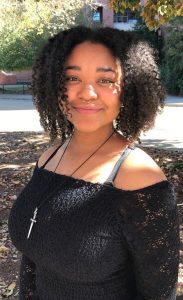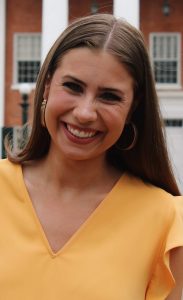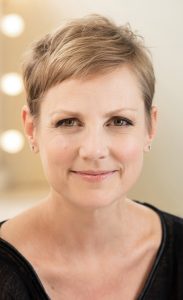
‘Near/Far,’ the second fall production from Theatre and Film at UM, uses an improvisational approach to explore isolation in this time of pandemic. The remotely performed and recorded work debuts this weekend on Facebook and YouTube.
OXFORD, Miss. – In the opening frames of “Near/Far,” the second fall-season production from the Department of Theatre and Film at the University of Mississippi, a series of glitchy, time-altered city scenes flicker by: traffic-crowded streets, pedestrian-packed sidewalks, daytime hustle and raucous nightlife.
Suddenly, everything goes black. Blurry rectangles of gentle color begin to appear, multiplying as they ease into focus.
Soon the scene is all too familiar: on the screen, a 9-by-9 grid. Ah yes, another Zoom meeting. Or is it? Because while the medium is familiar, the world on the other side and the creatures inhabiting it are unlike anything we have seen before.
“Near/Far,” a remotely performed and recorded work of physical theater conceived by Lauren Bone Noble, UM assistant professor of movement for the actor, will premiere online at 7 p.m. Friday (Nov. 6) on Facebook and YouTube; the Facebook premiere will feature an interactive “watch party.”
The play is, in essence, an exploration of isolation – something most people have become familiar with in recent months, with stay-at-home orders, social distancing, and remote work and schooling in effect to varying degrees across the globe. There is no dialogue, and the actors wear masks.
The piece is a response to the physical requirements and emotional consequences of the pandemic, Bone Noble said.
“That’s what’s going on now for us, when we’re meeting over Zoom, virtually all the time, and even if we do see people, we’re not really supposed to hug or embrace or touch, so we ourselves are living in a sterile environment,” Bone Noble said. “Well, what’s the impact on us?”
The nine creatures appear to have materialized in a strange new world, which Bone Noble said was inspired by photos of the R.M.S. Titanic at the bottom of the North Atlantic – “this idea of a space that’s left behind.”
“It’s kind of an ongoing Zoom meeting that never ends,” Bone Noble elaborated.
“These creatures wander in, and we allow them to explore the space and what happened to the creatures that used to live in this environment. … They discover each other, they discover the nearness and farness of the space. They can’t touch one another, but they can see one another.”
The masks, called “larval masks,” have blunt features, only vaguely suggestive of an expression, which Bone Noble said gives the actors “a lot of room to explore and to bring their own unique perspective of what (the character) is.
As a work of devised theater, the whole piece was developed during rehearsals. Bone Noble gave actors a “recipe” to work with, and as they improvised movements, the ones that worked were cemented into the choreography.
Reese Overstreet is a sophomore from Jackson in the acting for stage and screen program who plays Wary, the character who occupies the central frame of the grid. Overstreet said she had never done mask work before, and she found it enlivening.
“Putting on the mask creates the character and finishes the character completely,” Overstreet said. “It’s a surreal experience of putting on the mask and literally feeling like you’re being dropped into the character.”
The absence of dialogue also freed Overstreet to express herself, and her character, through movement, she said.
“Doing this without dialogue is the most freeing experience, because you don’t have to worry about a line,” Overstreet said. “You are just living in your body and doing what feels right. Obviously, there are things we’ve written down that we’re going to do, but because it’s so organic, it just naturally comes about.”
As freeing as it may be to perform without dialogue and with the aid of a character-defining mask, performing from home via Zoom meant that the actors also were responsible for some of the technical aspects of the production.
“When we’re performing, we have to make sure the lights are right,” Overstreet said.
“And there’s a point in the show where we have to change the green screen behind us, which is something that’s wild and I’ve never experienced before. … It teaches you to multitask, and it makes you realize how lucky we are to have so many people involved in a production.”
Another actor new to the world of Zoom theater is junior Ashley Wingo, a recent transfer into the acting for stage and screen program. This is Wingo’s first production with the department, as well as her first time acting without dialogue, and she said she especially enjoyed the intense focus on specific movements.
“I think my favorite feature or aspect of the entire production process is how intricate you have to be with your hands and feet, and even your torso, shoulders and head,” Wingo said.
“We have to focus so much on intricate movement, and that’s really a beautiful thing. Whenever I’ve watched myself, even when I’m in character, I watched my hand come towards the camera, and I just thought to myself, ‘Wow, we’re creating something completely new and different.'”
But when asked what the biggest challenge of this production was, Wingo didn’t miss a beat: “The intricate movement.”
Costume designers for the show – among them, senior McKenzi Massey, from Fort Myers, Florida –faced different challenges designing and preparing for this production. The design choices are inventive: All the actors wear matching coveralls, in dark navy, with a ski hood to keep hair smooth under the mask, plus gloves, and they also have bare feet.
It was the logistics of ordering costumes, getting them to the actors and doing fittings that were complicated.
“Fittings on Zoom are so bizarre!” Massey exclaimed. “It’s like, ‘Excuse me, can you please mute and turn your camera off and get changed?’ It’s very strange, and at first it was kind of awkward; it was a new learning curve.”
The designers chose coveralls with a looser, adjustable fit, which made it possible to avoid the kind of hands-on tailoring most costumes go through. Still, there were a couple of tweaks the actors had to make on their own.
“The coveralls had a little name brand tag on them,” Massey said. “So we had to send everybody Sharpies so they could color in the little box.”
Massey was responsible for finding the gloves that all the creatures would wear. Though the creative team initially talked of finding something “alien, extraterrestrial-looking, with claws,” Massey became intrigued by the idea of using common blue disposable gloves like those you might find in a doctor’s office.
“It’s kind of like the world of COVID, right?” Massey explained. “Everyone is trying to be sanitary, of course, and a lot of people are in hospitals. Also, these bright blue gloves show the separation, not contacting the real world.”
The ostensible minimalism of the production – sets containing only the actors’ own furniture draped with plain fabric; matching, monochromatic costumes; simple masks; and the lack of dialogue – belies an incredibly complex technological arrangement thrumming behind the scenes.
Jeffrey Hannah, the department’s master electrician, began working over the summer to learn – or reacquaint himself with – several different pieces of software that, when strung together the right way, make it possible for the actors to be recorded via Zoom, performing from their individual homes, while background effects are applied to green screens blanketing their walls and music, composed by Peter Wood, instructional assistant professor of theatre arts, is streamed in.
Hannah described the multiple layers of technology that he and other remote operators will manipulate to provide a seamless viewing experience. The various pieces of software and applications communicate with one another, beaming audio, video and automated cueing commands back and forth; the Zoom screen that audiences see is very different from the one the cast and crew will be looking at during the performance.
On top of all this, everyone will be logged into a social media program called Discord, allowing them to communicate with one another via voice and text chat in a way that won’t interfere with the Zoom performance.
Gianna Schuetz, a senior from Huntsville, Alabama, who is double majoring in theatre arts and managerial finance with a minor in entrepreneurship, is the production’s stage manager and lighting designer. Creating a theater production – and a work of devised theater – via Zoom presented interesting challenges for Schuetz in both her roles, she said.
“I’m used to seeing a theater ground plan, knowing what it looks like, knowing the script and being able to go in and touch and see the space I’m designing in,” Schuetz said of her role as lighting designer. “For stage management, I’m used to seeing actors in person and having a script up front, so just the virtual aspects to begin with are very different.”
For the lighting scheme, Schuetz had to design plans for nine totally different spaces – the actors’ bedrooms – and work with only what she could see over Zoom meetings and rough floor plans. Furthermore, she’ll be cueing the actors to adjust their lights.
Schuetz’s role as stage manager is markedly different, as well.
“Jeffrey (Hannah) has this program where, essentially, we become Zoom wizards,” Schuetz said. “So I’ll be on a call with the actors and also with the technical crew at the same time, and I’m going to be communicating with both and giving them both cues during the show, all over Zoom, which is very, very cool.”
Overall, Schuetz is excited to be learning new ways of making theater, and she sees this experience as an opportunity to prepare herself for whatever the future of theater may look like.
“A lot of Broadway’s not open, or won’t officially be opening until at least 2021,” Schuetz said. “And who knows? How much longer might that extend?
“I’m about to start applying to grad school, and this is certainly an experience I’ll be able to talk about. Zoom theater is about to be the future of what some theater is, so I’m excited that the university is offering this and that I can start working on projects.”
Bone Noble is pleased with the results of her first production as a new faculty member in the Department of Theatre and Film.
“This production is the culmination of a group of artists who asked ‘what if’ and then rolled up their sleeves and got to the work of answering that question,” Bone Noble said.
“The answer is this show, which is beautiful and silly and touching and strange. What moves me is the dedication of the artists who came together to make it happen. All of us have stretched past our comfort zones and I think, I hope, the result will be a show that resonates with the audience.”



